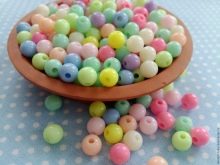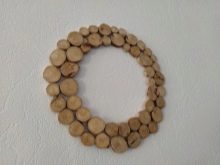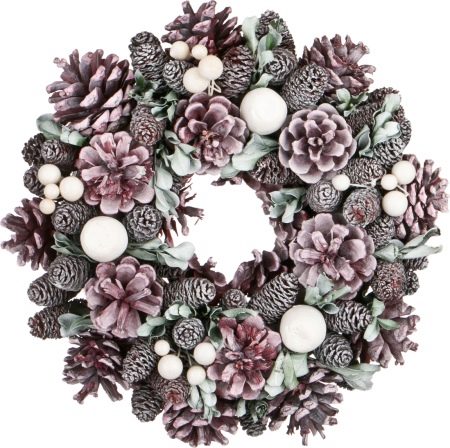Varieties of wreaths and their creation

A change in the room setting or a simple rearrangement of furniture perfectly affects the emotional background of the owners of the living space. Even a small change in accents, decorative elements will help a person feel happier.


What it is?
An interior wreath is a circular product made from various materials at hand, symbolizing the change of seasons, the onset of holidays, emphasizing the interior design. Such souvenirs have become part of our life and are increasingly popular. They can be purchased at souvenir shops, ordered by handicraftsmen and made by yourself. Making a designer wreath is not particularly difficult.



The peculiarity of accents of this kind lies in their ability to create a certain aura in the room, to positively influence the mood. In addition, making a wreath with your own hands is a creative activity that develops horizons, observation and imagination. The horizons expand due to acquaintance with information on the technique of performance, types of wreaths, observation helps to notice, select all new materials for creating compositions. Well, good fantasy is a mass of ideas, an endless variety of their embodiment.


Wreaths of any season will decorate the doors and walls of the living room. All of them are beautiful in their own way, they can be brightly catchy or calmly pacifying. It all depends on the materials chosen - for example, a wreath of meadow grasses and cornflowers is rather a pleasant addition to everyday life, but the decor of roses, lilies, peonies is a holiday, an extravaganza of shades and aromas. Autumn wreaths with yellow and red hues will bring a colorful touch and positive to the cloudy season.


Species overview
Interior wreaths made of natural or scrap materials set the general tone for the interior, emphasize and accentuate the change of seasons. They have become an obligatory accessory for holidays (weddings, Christmas, New Years) and mourning (ritual wreaths, although they cannot be called interior wreaths).
Fortunately, we are talking about the holiday and decorative wreaths.



All decorative wreaths are plant or floral compositions, divided into 2 main types.
-
Wreaths made of artificial materials - flowers, branches, jewelry, leaves, etc. Their main advantage is durability. Some, mentioning the advantages of artificial wreaths, for some reason note their cheapness, but here one can argue. Buying materials for creativity, even on Aliexpress, is far from cheap spending, while collecting plant materials and preparing them does not cost anything. Is that - payment of travel expenses, if next to the house there is no park or forest.



- Wreaths made from natural ingredients - everything that grows around us. This is all that can be used to make blanks that can be picked up in nature - cones, acorns, twigs, twigs, twigs, dried flowers, beautiful stems of wild flowers and weeds, ears, grass panicles, etc. The exception is floristic compositions ordered in flower shops - they are really very expensive.



Weeping birch or willow are ideal for making frames. Their thin and flexible branches are twisted into a hoop of the required diameter, fixed, and the workpieces are left for some time. Dried up, they keep their shape perfectly and become an excellent basis for creating an interior wreath. In addition, wreaths differ in subspecies.


By appointment
Transparent - there is no exact translation, but the definition in relation to wreaths implies "transparency", the airiness of the base. Simply put, these are the very frameworks made of branches, rods, as well as wire, etc. That is, the base should not be monolithic. Flowers, stems and other decorative materials are woven into a linear blank. The wreath can be suspended or supported in the form of a vase and podium.


In such compositions, an alternative assembly of elements is sometimes used - special vessels for moisture, in which the stems of living plants are located. Design wreaths do not have just technical details, except perhaps for the frame. All other parts are decorative. Such products can be safely called frames without frames, combining luxury, grace and natural minimalism.
- Vegetative typemade of wildflowers and plants, which is a woven ring of herbs, branches, flowers. The same wreath that since ancient times was not only an ornament, but also a symbolism among the Slavic and many other peoples. For some peoples, the wreath was a symbol of victory or martyrdom (the crown of thorns of Christ).
For others, the ancient Slavs, the wreath was a solar (solar) symbol with a magical sense of perfection and unity, had the power of a talisman.


- Decorative - an element of interior design, decorative detail. It is made from a variety of materials, selected according to the style of decoration of the room.



Seasonality
Autumn - capable of blooming the twilight of withering nature, the onset of cold weather, the proximity of winter frosts and long nights, to disperse the blues. Mandatory elements of such wreaths are bright details, colorful fruits - decorative pumpkins, physalis, yellow and red leaves, and, of course, brown blotches of acorns, cinnamon sticks and vanilla, various aromatic spices with their invigorating but warm aromas.


Winter - preparations for them must be done in advance, in the autumn-summer season, while there is an opportunity to get out into nature and collect plant materials - cones, leaves, fruits of chestnuts, etc. It is more correct to dry orange slices in advance, prepare clusters of mountain ash and viburnum. Dry well the collected cones, after thoroughly rinsing them.Recently, bleached buds have become very popular.
Whichever article you open in order to find out how this is done, the advice is the same everywhere - whitening with whiteness. So, if whiteness is capable of whitening the woody scales of cones, then a maximum of one tone, even if they are boiled and kept in solution for a week. But what you will not find in the articles is a valid whitening recipe. The cone can only be lightened with the help of building compounds for bleaching wood - the stronger the concentration, the lighter the final result will be.


Spring - there are practically no materials for their creation in nature, she is sleeping. But on the other hand, there is a great opportunity to make a composition of artificial materials in a targeted direction, for example, an Easter wreath.


Summer - all the splendor of nature is at the disposal of a creative person - grasses, flowers, shrubs - a lot of greenery and bright colors. By the way, summer is a time of preparations for creating compositions for the New Year and other holidays.


How to do it yourself?
Making wreaths with your own hands is not just creativity, but one of the types of profitable needlework. Decorating houses with wreaths for the holidays is becoming a custom; there are many thematic solutions for the holidays or seasons. Weaving a wreath is not that difficult, but this skill is not needed when creating decorative wreaths. Their manufacture is possible from any natural materials:
- acorns and cornflowers;
- rattan and wine corks;
- grapevine, willow, ears of corn;
- physalis, wheat, lavender, sunflowers;
- felt, beads, roses, peonies, birch, moss, nuts.



The wreath can be herringbone, oak, from knitted yarn, with ribbons and bows, they can be alive, from fruits and vegetables, oranges, pumpkins, etc.
Crafts for a holiday made of wine corks are quite symbolic, if only they were not the only decorative elements of the wreath. How to make a wreath step by step will be described below.
The first thing to do is to prepare the base of the wreath; there are several ways to make it.
- Buy a ready-made base in the store - the most costly and uninteresting way. Outlets offer a wide range of products of this type - from foam, grapevine, rattan, straw, iron rods.

- Cardboard base - make a stencil, cut a circle out of cardboard along it and give it volume. To do this, crumple the paper and attach it to one side of the cardboard with tape.

- Using wrapping paper - The easiest way. The paper is crumpled into a cylindrical "sausage", a circle is formed and wrapped with tape or twine.


- Using an aluminum soft baking dish - the variety of its forms allows to diversify the outline of the future wreath just as much.


- The base can be cut from a piece of Styrofoam.

- One of the best ways to make a great model is to use pipe insulation. It has a wide selection in diameter and costs a mere penny. Cut the required length of the soft pipe and connect with tape or hot glue.

- Wire hangers for clothes - these are usually sold in a fixed price list. The ends are separated, then the product is rounded and the ends of the wire are reattached. Subsequently, it is wrapped with thin foam rubber, padding polyester to give it volume, and then covered with burlap.


- Blanks from branches - they are cut in autumn, a hoop is formed from them, fastened and left to dry in this form.


After the base is ready, you can start decorating the structure with prepared decorative elements according to the sketch and theme.
Winter
One of the variations of winter wreaths is the berry Christmas wreath. The design of the proposed wreath of pine branches looks extremely elegant, thanks to sparkling ruby berries and leaves against the background of needles dusted with snow. For this you will need:
- fresh pine twigs;
- spray with artificial snow;
- cones, decorative carmine berries and leaves, small Christmas balls, glue gun, twine, decorative red berries and leaves.


Step-by-step execution of work.
- Pine branches must be collected in a circle and secured with twine.
- The assembled structure is sprayed with "snow"; in its absence, white spray paint can be used.
- The wreath sprinkled with hoarfrost is decorated with red berries and leaves using hot glue.
- After that, add a few cones.
- As a final touch, the wreath is decorated with balls - the composition is ready.





You can add a flower of the Christmas star - poinsettia to the wreath.

A few more options for a festive winter composition are ice wreaths.
- To make this wreath, you will need a baking dish with a ring insert inside. A little water is poured into the bottom of the mold and bright decorative elements are beautifully laid out - berries, coniferous twigs, and then sent to freeze. After the water with the decorations freezes, the mold is completely filled with water and re-frozen. The frozen mold is immersed in hot water. The ice lags behind the walls, an ice ring with a frozen winter decor is taken out and hung on a beautiful ribbon.


- For this composition, you will need several small pudding trays. The whole algorithm is repeated, resulting in several miniature wreaths. They can be used to decorate a Christmas tree outside by hanging them on satin ribbons.


- A queue of a large ice wreath - in a large deep baking dish, place a jar in the center, top it up with water or fill it with stones so that it does not float. The prepared decor is laid around - slices of lemons, oranges, thuja twigs, bright berries and sent to the freezer or outside. After freezing, the wreath is taken out and hung on the street. In this case, it is necessary to take into account the weight of the product and choose a strong twine for it.


- And finally, the last option - plastic snowflakes, Christmas balls are placed in a form with a vertical insert, tinsel and even an LED garland can be added, a small amount of water is added so that the decor does not float. All this is sent to the frost.


After the first layer freezes, add some more decor and add water. The frozen composition is hung out on the street using a beautiful bow.
Autumn
An unusually beautiful interior wreath - you will need a lot of material to make it:
- 2 wreaths of twigs, 3 decorative pumpkins, bunches of mountain ash or hawthorn;
- colored small balls, paper with drawings of leaves, several bunches of dry leaves;
- cones, acorns, a couple of twigs, a few feathers, wire, a glue gun.




Now you need to connect 2 wreaths together, you can use one, but voluminous. Wreaths should be transparent - made of twigs or wire.
- Bunches of small berries are glued on top of the wreath.
- The composition will become more colorful and vibrant if you add artificial berries.
- The next step is to attach decorative pumpkins, previously coated with glitter varnish.
- The composition is complemented with cones and acorns.





Almost all materials are freely available on the street.
Spring
One of the seasonal types of wreaths, slightly less popular than holiday compositions, is spring. Attention is offered step-by-step instructions for making a not too complicated wreath.
Necessary materials:
- scissors, wire, glue gun, small bird pattern;
- base for a vine wreath, live bulbs of spring primroses, bright feathers;
- synthetic winterizer, fabric for sewing birds, twigs, moss, needles and threads.

Having collected the necessary tools and materials, you can start making a wreath with your own hands.
- A wire is passed along the perimeter of the base, thereby fastening the future frame.
- Now it's the turn of the birds - the blanks are cut out of the fabric from the template.
- The cut is sewn in pairs, leaving a small hole through which the carcasses are stuffed with padding polyester.
- The hole left is sewn up.
- The decor is laid out on the wreath.
- With the help of hot glue, all parts are attached to the base.





Actually, you can see everything from the photo, and even a beginner can make a wreath on his own.
Wreath made of wood cuts, made in eco-style
It will take a little time to create it, especially if you have a power tool at your disposal - a saw, a grinder, a furniture stapler, staples. However, all this can be replaced with a hacksaw, emery cloth, glue. To complete one wreath, you will need up to 55 cuts. This is more than enough for a wreath with a diameter of 35–40 cm. For cuts you need to choose a deciduous tree, for example, a birch. The bark can be removed, but you can also leave it - the small thickness prevents the wood from rotting.
- The surface of the finished cuts must be sanded to make it as smooth as possible.
- Then cover with wood stain, which gives them a beautiful shade.
- A plate is laid on the table, and wooden rounds are laid out around it face down. During this stage, you must ensure that the same width of the "hoop" is observed.
- After completing the layout, adjusting the rounds to each other, the sides are fastened with a stapler and the back side is coated with an adhesive. After that, the structure is sent under the press - so it will remain flat and fit snugly against the wall.
The front side of the finished wreath must be covered with PVA glue as a primer.





Wreath decor
If after work there are some cuts left, then they can be painted in various shades, glued on one side of the wreath and decorated with burlap braid. In principle, any will do, but burlap and wood are ideal companions.
You can also stick on twigs, leaves, etc. It should be remembered that the decor should take up as little space as possible and leave the original texture of the product in plain sight. It is undesirable to choose a larger diameter for the wreath, because it starts to "walk".


Beautiful examples
Amazingly beautiful New Year's wreath made of pine and spruce cones, decorated with balls and leaves. The wreath is made in a lilac-silver palette of powdery shades. The entire surface is covered with a pearlescent spray.

Autumn wreath on a transparent basis. The product is made of thin branches of weeping birch, red-yellow leaves, artificial branches with strung multi-colored berries. The whole composition is designed in traditional autumn colors - red-yellow-brown tones.

A graceful and delicate wreath in the Provence style. The base of the wreath is white-painted rattan rings. The composition consists of an artificial flower set and twigs, complemented by a miniature decorative birdhouse, fancy berries. The wreath is intercepted at the top with a green satin ribbon.

For information on how to make an interior wreath in a marine style with your own hands, see the next master class.








